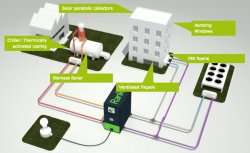Energy reduction in public buildings: learning to lead from the front

Buildings in EU-27 Member States represent up to 24 billion m2 of floor space, responsible for 40 percent of Europe's energy consumption and 36 percent of CO2 emissions – both key contributors to climate change. In response, a number of European directives promoting energy efficiency and ambitious goals for achieving nearly zero-energy buildings will be enforced in the coming years.
Public buildings are expected to meet these challenges and act as frontrunners. It is time to use the wealth of resources already at our disposal to accelerate change.
The results of four and half years research and demonstration testing are now being made available to help local authorities and professionals work faster and with more confidence to meet national and European energy goals. BRICKER's retrofitting solution package is a proven basis for reducing energy consumption in non-residential buildings.
A series of active and passive solutions have been tested and implemented in two real-world demonstration buildings (Liege, Belgium and Aydin, Turkey) and a simulation case study (Caceres, Spain). These are located in different countries and with different end uses to show the vital ingredients for success and that technology transfer can travel easily.
To transfer vital ingredients of these energy-efficient practices quickly and effectively, BRICKER is making technology integration, guidance for implementation and transfer support available to public and private building owners, architects, engineers, policymakers and more.
Numerous insights in each of the following areas are available to increase impact, build confidence, and save time and money in:
- Envelope retrofitting solutions
- Zero-emission energy production technologies
- System design, operation and maintenance
- Energy modelling and monitoring
- Energy regulations and certification schemes
Using the BRICKER approach has helped achieve between 20 and 33 percent of economic savings at energy-intensive sites across various European climate zones. Typically, demonstration sites are also on track to meet a top line target of 50 percent less energy consumptions and return on investment in a targeted seven years. With tools like these, investing in our future has never looked so good.
More information: Project website: www.bricker-project.com/
Provided by CORDIS




















